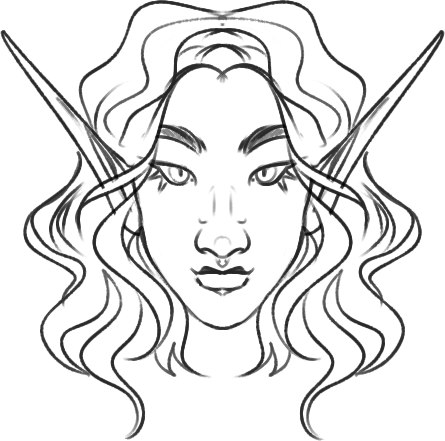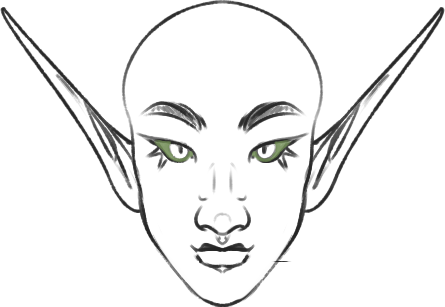Gannea TRAITS
Return to Gannea Species Directory
Gannea traits are genetic, environmental, and vary. Gannea grow feathers, fur, scales, fins, and crystals on their tails and limbs, unless the Sphynx mutation is present.
dermis
Filaments
Hair
Gannea display human hair growth patterns based off genetics. Gannea can have hair of any hair type, from 1A to 4C. Gannea can grow hair anywhere on their tails, such as a tuft on the tip, or a mane down the top. Hair may also grow anywhere on the limbs.
straight hair
- 1A-1C hair.

wavy hair
- 2A-2C hair.

curly hair
- 3A-3C hair.

Coiled Hair
- 4A-4C hair.

Feathers
Gannea can grow feathers on their tails of any type. These may range from down, flight, to display feathers. They can grow anywhere on the tail, such as a flare at the base, to a fan at the tip. Feathers will periodically molt once every Gallan sub-year. Feathers may also grow anywhere on the limbs. Typical of "Avian" Gannea.
Fanned
- A fan of feathers anywhere on the body.

phoenix
- Long, trailing, fluffy feathers.

display
- Long, trailing feathers with a rounded tip.

Fur
Gannea may be covered in fur. This fur can vary in length and type, from downy, wiry, curly, or flowing. Fur may also grow anywhere on the limbs. Typical of "Mammalian" Gannea.
Short
- Typical mammalian body fur.

Double coat
- Two layers of fur, for insulation in cold environments. Lots of shedding.

Long
- Long, trailing fur.

Angora
- Fur like an Angora rabbit's, which can be cut and spun into fiber and used to make fabric.

dermal growths
scales
Gannea may grow various scales all over their bodies. However, these scales can be varied and sorted into different types, and come in any shape, pattern, or size, as well as be tubercular, platelike, or imbricate. Typical of "Reptilian" and "Aquatic" Gannea.

cycloid scales
- Round, overlapping circular scales

granular scales
- Bumpy, raised scales of varying size and shape.

keeled scales
- Scales with a central ridge, can be platelike or imbricate.

Fins
Fins may grow anywhere on the Gannea's body, of varying types and shapes. They are typical of "Aquatic" Gannea.
Lobe Fins
- Cartilaginous spined fins.

Ray fins
- Soft, ray fins.

cartilaginous fins
- Fins made entirely of cartilage.

crystals
Crystal growths are the rarest of the Gannea dermal traits, only present on the rare Crystalline Gannea.
point crystals
- Pointed or jagged crystal growths.

rounded crystals
- Round, smooth ovalline or circular crystals.

Cut crystals
- Crystals in any "cut" shape.

Horns
Gannea horns can vary in color, shape, size, amount, and even composition. Any horn type is capable of growing singularly or in multiple sets on the head. Horns may look like anything.
Hornless
- No horns.

Antlers
- Dead bone without a horn or skin covering that are periodically shed and regrown. Typical of "Mammalian" Gannea

keratin
- Composed entirely of keratin and grow continuously, must be trimmed. Typical of "Avian" Gannea.

ossicones
- Bony horns covered in skin with scales or fur. Typical of "Reptilian" Gannea.
![]()
bone
- “True” horns, a permanent extension of the skull with a keratin covering. Typical of "Aquatic" Gannea.

crystallized
- Crystalline horns occur when the bone of the horn is crystallized, similar to a Crysalla's. Typical of "Crystallized" Gannea.

head
ears
Gannea have long, pointed ears that are fully mobile, able to swivel around to hear any incoming danger.
standard
- Long, pointed, bare ears.

Tufted
- Ears with fur either in the inside or on the tips or lobes.

Feathered
- Feathered ears, some resembling wings.

Ribbed
- Extended ears, with a curled tip.

Finned
- Ears extend into fins of any three types.

Flare
- Large, notched ears.

eyes
Gannea irises come in any color imaginable!
Light Sclera
- Light-colored sclera.

Colored Sclera
- Sclera is any hue.

dark sclera
- Sclera is dark colored.

Wings
Gannea are categorized by subtype by the wings they inherit from their parents. They have various wing types, as well as wing shapes.
types
This is what the Gannea's subtype is based on.
Wingless
- Wings failed to develop in utero.
Mammalian wings
- Feathered bird wings, typical of "Mammalian" Gannea.

Avian wings
- Clawed feathered bird wings, typical of "Avian" Gannea.

Reptilian Wings
- Membrane wings with feather covering, typical of "Reptilian" Gannea.

Aquatic Wings
- Membrane wings, no feathers. Typical of "Aquatic" Gannea.

Crystalline Wings
- Membrane wings, with a hand upon the wrist.

wing shapes
standard
- Built like a bird of prey; optimized for speed, agility, and raw strength.

active soaring wings
- Long and narrow, adapted for soaring without flapping for long periods of time over long distances over water to conserve energy

PASSIVE SOARING WINGS
- Long and broad, capable of soaring without reliable wind currents

elliptical wings
- Short and wide, capable of fast and tightly controlled flight, and easy maneuverability through obstacles like trees

hovering wings
- Smaller relative to body size, capable of sustained hovering, rapid wingbeats, and tightly controlled flight

tails
Gannea have three tail lengths, as well as various tail types, applicable to any tail length.
lengths
standard tail
- Average tail, roughly the length of half the Gannea's armspan.

Long tail
- Long tail, the length of the Gannea's full armspan.

Short tail
- Short tail, the length of one of the Gannea's arms.

types
Gannea have several types of tails, with various traits that can be mixed and matched!
furred
tufted
- Tail has a tuft of hair at the tip.

maned
- Tail has a mane of any length or style running from the base to tip.

Feline
- Tail is fully covered in thick fur of varying length, like a cat's.

feathered
fanned
- Tail has a feathered fan at the tip of the tail, can be any shape.

Raptor
- Tail has a row of feathers on both sides from the base to tip.

Avian
- Bird's tail, feathers of any length.

scaled
spade
- Scaled tail ending in a sharp, pointed tail spade.
Spined
- Tail is covered in spiny projections.

Vane
- Tail ends with a vane, similar to a pterosaur.

finned
Lobe Finned
- Tail has cartilaginous spines on the fins, can be any shape or size.

ray Finned
- Tail has soft, ray fins of any shape or size.

Cartilaginous Finned
- Tail has cartilaginous fins, of any shape or size.

Crystalline
Crystalline Spade
- Crystal pointed spade at the tip of the tail, can be any shape.

Crystalline Spines
- Bony spines have become crystallized.

skeletal
- Bony, crystallized vertebrae growths on the top of the tail that wrap around the sides.

